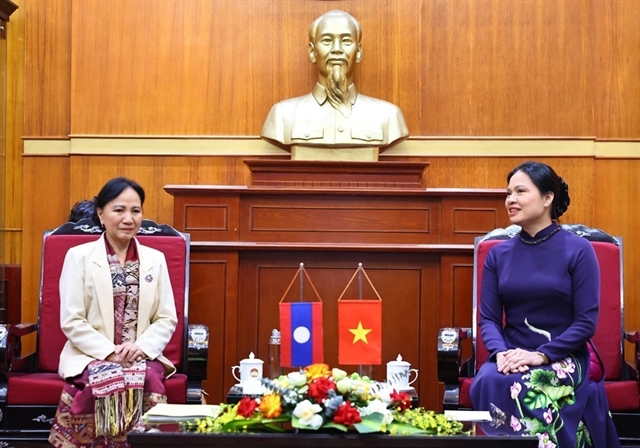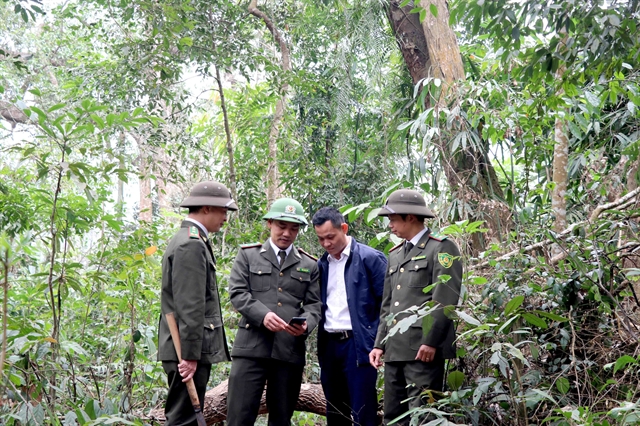 Environment
Environment

 |
| Forest rangers of Sơn Dương Forest Ranger Station use Locus Map to monitor and manage the forest. VNA/VNS Photo Hoàng Hải |
TUYÊN QUANG Tuyên Quang province has implemented robust mechanisms and policies to effectively harness the potential of its forests. These initiatives have garnered strong support from the local community, leading to improved forest management, protection and development.
As a result, forest growers' livelihoods have been enhanced, and their bond with the forests strengthened. This integration of forestry development with other economic sectors has bolstered the province's socio-economic progress.
With 448,000ha of forestry land, constituting 76 per cent of its natural land area, Tuyên Quang ranks third nationally in forest coverage, at over 65.21 per cent. Key strategies such as forest allocation, the adoption of technology for management, and heightened awareness campaigns against illegal logging have been instrumental in promoting sustainable forest management.
Effectiveness of forest allocation
Mai Thị Hoàn, Deputy Director of the provincial Department of Agriculture and Rural Development, highlighted the successful implementation of a Government decree which links forest protection and development with sustainable poverty reduction policies.
From 2016 to 2020, over 85,000ha of natural and protective forests were allocated to 4,104 households of ethnic minorities, with a total support fund exceeding VNĐ132 billion (US$5.2 million). This policy has curbed forest violations, raised awareness and responsibility on forest protection, and provided additional income for locals.
Some success stories linked to this decree include Đặng Hữu Minh of the Dao ethnic group in Chạp village, Trung Sơn Commune, Yên Sơn District.
Minh has actively participated in forest protection allocation for nearly a decade. He and his fellow allocated households have formed patrols to effectively monitor the forest. Minh patrols the forest two to three times per week, utilising his deep knowledge of the area to navigate and assess its condition.
A neighbour of Minh, Đặng Phúc Hoàng, also has four years of experience in forest protection, managing 24ha of forest in Trung Sơn, boasting pristine conditions and abundant valuable plant species like agarwood, rattan and Dalbergia odorifera.
Hoàng also added that forest protection efforts have ensured secure water sources for local activities and agricultural production, replacing the need for pumping water from the river.
According to Chẩu Xuân Chức, Chief of Kim Quan Forest Ranger Station of Yên Sơn Forest Ranger Unit, his station manages over 5,250ha of forest in Trung Sơn and Kim Quan Communes, Yên Sơn District, as well as overseeing 914ha of allocated forest protection areas involving 251 households. The allocation has heightened local responsibility, turning residents into vital informants and collaborators with forest ranger forces, leading to effective management, with no forest fires or illegal logging incidents recorded in recent years.
Forest protection in the new era
To improve management efficiency and effectively monitor forest resources, Tuyên Quang Province's forest ranger forces have embraced information technology applications.
Triệu Đăng Khoa, Deputy Chief of the Provincial Forest Protection Department, explained that forest ranger units are utilising software like Locus Map and remote sensing technology for forest management and protection. These applications, integrated into tablets and smartphones, offer features like measurement, field inspection support, and forest status updates, aiding officials in detecting abnormal changes and updating forest resource data accurately.
The Cham Chu Special-Use Forest, spanning nearly 15,000ha across 83 hamlets and villages in five communes, is difficult to continually monitor due to its vast size. According to Nông Giang Nam, Deputy Chief of the Forest Ranger Sub-Department, although his unit has 26 forest rangers and officers patrolling, it is still not enough.
Since 2013, the adoption of Locus Map software has greatly facilitated the monitoring of forest changes for the unit. This application offers current maps, user positions, sub-compartment boundaries, and coordinates for photography and filming, essentially transforming phones into GPS devices. It continuously updates specific information, such as location, forest type and contact details of village leaders, enabling forest ranger officials to promptly monitor and address developments within their assigned forest management areas.
Tuyên Quang Province has derived valuable lessons from its practical experiences and achievements in forest management and protection. These lessons underscore the importance of strong leadership from the Party and Government in enhancing the roles and responsibilities of agency and organisation leaders in forest protection and development. They also emphasise the necessity of cohesive coordination among various sectors, local authorities, forest owners and communities, as well as the investment in advanced technological equipment and scientific methods for effective forest management.
According to Hoàn, forest management and protection should be closely integrated with economic development to improve the material and spiritual lives of the people. This entails ensuring that residents in forested areas derive economic benefits from the forests, promoting local participation in forest protection alongside eco-tourism development, and establishing value chains for wood and wood-based products. Ultimately, creating sustainable livelihoods and enhancing people's well-being is a key long-term solution. VNS




